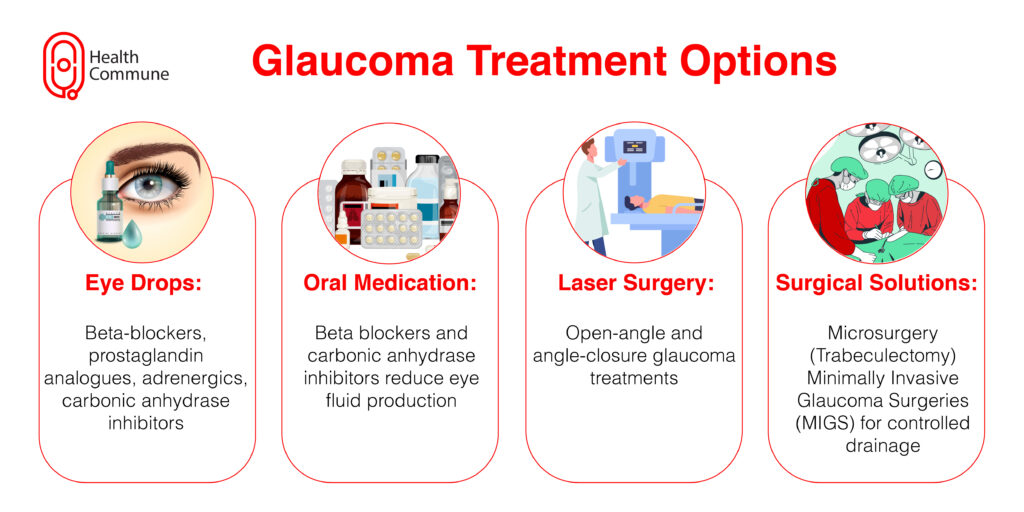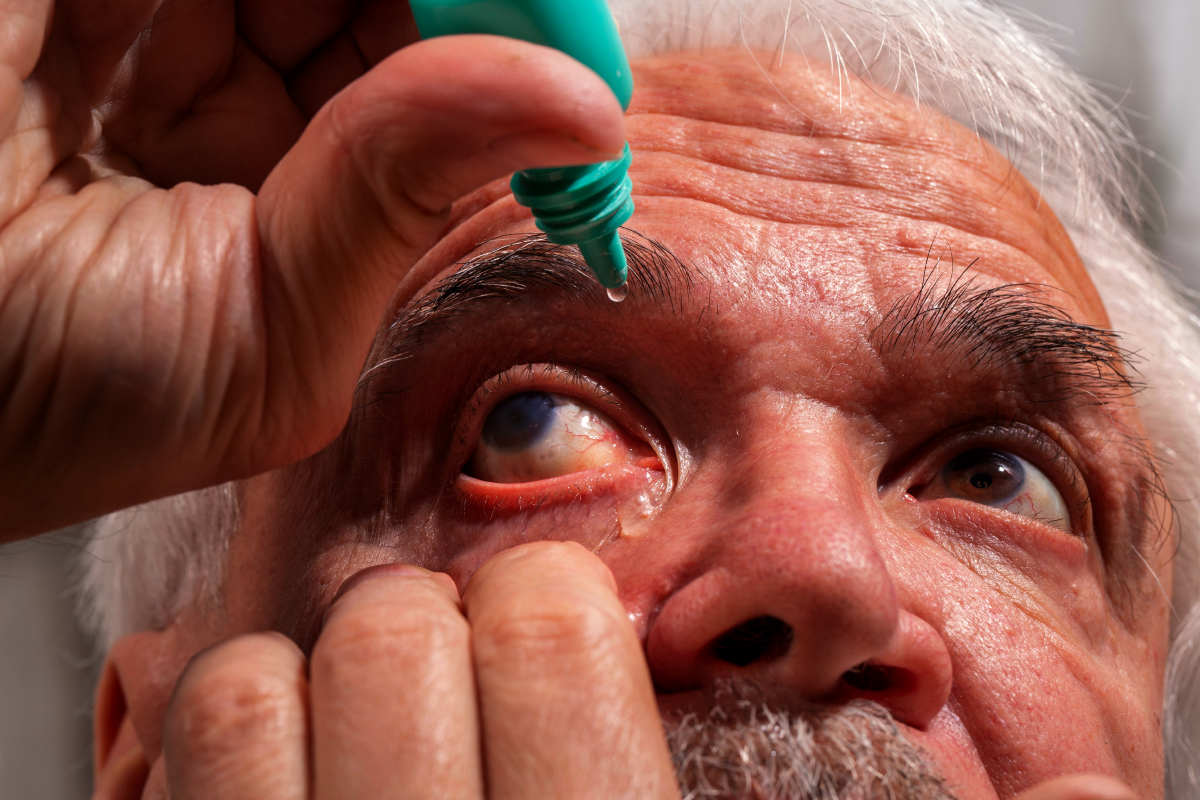Glaucoma is a group of conditions that cause damage to the optic nerve. It is one of the leading causes of blindness in people over the age of 60. Although acute angle-closure glaucoma is a medical emergency, there are other types of glaucoma that have no early symptoms, and your vision may seem normal until the problem is advanced. This article explains glaucoma, its symptoms, diagnosis, and treatment.
What is glaucoma?
What are the types of glaucoma?
The four main forms of glaucoma are:
- Open-angle glaucoma
- Angle-closure glaucoma (also called closed-angle glaucoma)
- Congenital glaucoma
- Secondary glaucoma
Open-angle glaucoma is the most prevalent form of glaucoma and cause remains unknown. Over time, the ocular pressure gradually rises. The optic nerve gets compressed against this increasing pressure, and, as a result, blind spots occur in your vision. Open-angle glaucoma frequently runs in families.
Angle-closure glaucoma (closed-angle glaucoma) develops when the intraocular fluid gets suddenly blocked and cannot flow out of the eyes. It leads to a sudden, significant increase in ocular pressure. Acute glaucoma attacks can be brought on by dilating eye drops and some medications.
Closed-angle glaucoma is an emergency condition.
Congenital glaucoma occurs when the eyes do not develop normally. Here, the angle of the anterior chamber of the eye is abnormal, leading to high intraocular pressure. This is usually detected at the time of birth.
Secondary glaucoma develops because of some underlying cause. Medications like corticosteroids, illnesses of the eyes such as uveitis (an inflammation of the middle layer of the eye), diseases like diabetes, and eye damage are some of the reasons for secondary glaucoma.
What are the causes of glaucoma?
Glaucoma can develop without any known cause, but a number of things can influence it:
- High intraocular eye pressure can cause mechanical strain on your optic nerve and lead to damage to the nerves in the eye and an altered blood supply. This increase in pressure can be due to factors like genetics, and increasing age
- Insufficient blood supply to the optic nerve
- Exposure to toxins such as free radicals, and nitric oxide

What are the risk factors for glaucoma?
Some risk factors for glaucoma include:
- Positive family history
- Increasing age
- Short-sightedness
- Diabetics
- High blood pressure
- Cigarette smoking
- Unregulated usage of topical drugs like steroids
What are the symptoms of glaucoma?
Certain types of glaucoma are usually difficult to diagnose because there aren’t any warning signs. Symptoms of vision abnormalities may appear gradually, making them easy to overlook. Routine eye exams are crucial for identifying open-angle glaucoma because many sufferers don’t exhibit any obvious symptoms; symptoms of closed-angle glaucoma are more severe and appear unexpectedly. You may encounter any type of these symptoms, like:
- Eye pressure or discomfort
- Headaches
- Lights with rainbow-coloured halos
- Vision problems such as tunnel vision, poor eyesight, blurriness, or blind spots
- Difficulty in reading or looking at things up close
- Nausea and vomiting
- Redness of the eyes
How is glaucoma diagnosed?
To detect glaucoma or other eye issues, routine eye exams are crucial. An eye doctor may do one or more of these painless tests to check for glaucoma
- Tonometry is an ocular test that is used to measure eye pressure. Most commonly, a puff of air is blown into your eye as you look at a bright light
- Dilated eye exam is done to visualise the optic nerve at the back of the eyes
- Visual acuity test (eye charts) is used to check for vision loss
- Visual field testing checks your field of vision. Cover one eye and look straight ahead while your doctor stands in your peripheral vision, holding up his fingers, and asks you how many you can see
- Optical coherence tomography is used to examine for abnormalities in your optic nerve
- Pachymetry is used to measure corneal thickness
- Slit-lamp exam uses a specialised microscope called a slit lamp to examine the interior of your eye
How is glaucoma treated?
Glaucoma that is left untreated can hasten the progression of permanent vision loss and blindness. If you are experiencing eye pain, headaches, or problems with your vision, it’s crucial to consult with a doctor as soon as possible. The initial treatment includes eye drops and oral medications, and then in the later phase, further procedures like laser treatment and surgeries are usually done.
Eye drops are used to decrease intraocular pressure by either accelerating the passage of the fluid out of your eyes or reducing its production. These include beta-blockers, prostaglandin analogues, adrenergics and carbonic anhydrase inhibitors. Common side effects include allergies, redness, stinging, blurred vision, and itchy eyes. Make sure your doctor knows all of your current medications and any other medical conditions you have because there may be drug interactions.
Oral medications such as beta blockers and carbonic anhydrase inhibitors are mostly prescribed as they reduce fluid production in the eyes.
Laser surgery can cause a modest increase in the drainage of fluid from your eyes if you have open-angle glaucoma. If you suffer from angle-closure glaucoma, it can prevent fluid blockage. Procedures for lasers consist of:
- Trabeculoplasty, which is used to open up the drainage area
- Iridotomy is a medical procedure in which a small hole is created in the iris. This opening is made to improve the flow of aqueous humor, the fluid that circulates within the eye.
- Cyclophotocoagulation which reduces fluid production by treating the ciliary process
Surgery is another way to reduce eye pressure; it also provides better eye pressure control than eye drops and oral medications in severe cases. This includes :
Microsurgery: It is a procedure in which your doctor constructs a new channel to drain the fluid and lower eye pressure during a treatment known as a trabeculectomy. This surgery has to be done more than once
Minimally invasive glaucoma surgeries (MIGS) are less invasive surgeries that use microscopic apparatus to make tiny openings and allow fluid to drain
How can I prevent glaucoma?
You can’t prevent glaucoma, but if you identify it early, you can lower your risk of permanent vision loss. Some preventative measures include:
Regular eye checkups should be done every one to two years if you are over 40 years old and have a family history of the condition. You might need checkups more frequently if you have health issues like diabetes or are at risk for other eye illnesses
Protect your eyes by wearing protective eyewear
Follow your doctor’s instructions if you have been diagnosed with increased intraocular pressure
What are the complications of glaucoma?
Can glaucoma be cured?
Unfortunately, there is no cure for glaucoma at present. You can, however if identified and managed well, you will be able to control the symptoms and delay the progression of the disease.





